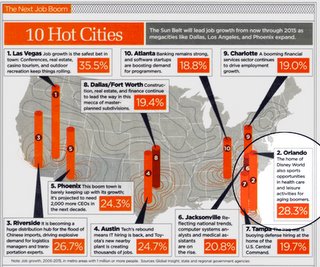I really do believe a lot of people never really find their "career calling." It's never too late to change careers! Yes, it may take some additional sacrifices and education to excel in your new career choice, but if your current path does not have passion, then it might be time to make a CAREER change. The next problem is deciding out what you want to do. If you are reading this and would like to find out what other types of jobs are out there, I may have some help. If you have children who need some career path information, this information is very valuable.
The US Government has a website that breaks down 1,000's of careers in detail. Please visit
http://www.bls.gov/oco/. Here you will find fantastic information about potential career paths. Here is a sampling of careers they profile along with earning potential.
Diagnostic Medical Sonographers
http://www.bls.gov/oco/ocos273.htmDiagnostic imaging embraces several procedures that aid in diagnosing ailments. Besides the familiar x-ray, another common diagnostic imaging method is magnetic resonance imaging, which uses giant magnets that create radio waves, rather than radiation, to form an image. Not all imaging technologies use ionizing radiation or radio waves, however. Sonography, or ultrasonography, is the use of sound waves to generate an image for the assessment and diagnosis of various medical conditions. Sonography usually is associated with obstetrics and the use of ultrasound imaging during pregnancy, but this technology has many other applications in the diagnosis and treatment of medical conditions.
Median annual earnings of diagnostic medical sonographers were $52,490 in May 2004. The middle 50 percent earned between $44,720 and $61,360 a year. The lowest 10 percent earned less than $37,800, and the highest 10 percent earned more than $72,230. Median annual earnings of diagnostic medical sonographers in May 2004 were $53,790 in offices of physicians and $51,860 in general medical and surgical hospitals.
Geoscientists
http://www.bls.gov/oco/ocos288.htmGeoscientists study the composition, structure, and other physical aspects of the Earth. With the use of sophisticated instruments and by analyzing the composition of the earth and water, geoscientists study the Earth’s geologic past and present. Many geoscientists are involved in searching for adequate supplies of natural resources such as groundwater, metals, and petroleum, while others work closely with environmental and other scientists in preserving and cleaning up the environment.
Median annual earnings of geoscientists were $68,730 in May 2004. The middle 50 percent earned between $49,260 and $98,380; the lowest 10 percent earned less than $37,700, the highest 10 percent more than $130,750.
Boilermakers
http://www.bls.gov/oco/ocos221.htmBoilermakers and boilermaker mechanics make, install, and repair boilers, vats, and other large vessels that hold liquids and gases. Boilers supply steam to drive huge turbines in electric powerplants and to provide heat and power in buildings, factories, and ships. Tanks and vats are used to process and store chemicals, oil, beer, and hundreds of other products.
In May 2004, the median hourly earnings of boilermakers were about $21.68. The middle 50 percent earned between $17.80 and $26.82. The lowest 10 percent earned less than $14.07, and the highest 10 percent earned more than $32.46. Apprentices generally start at about half of journey-level wages, with wages gradually increasing to the journey wage as progress is made in the apprenticeship.
Go ahead and browse the 1000's of career possibilities at this site. I think you will find some career paths and positions that may grab your attention and give you some career guidance for the future.
